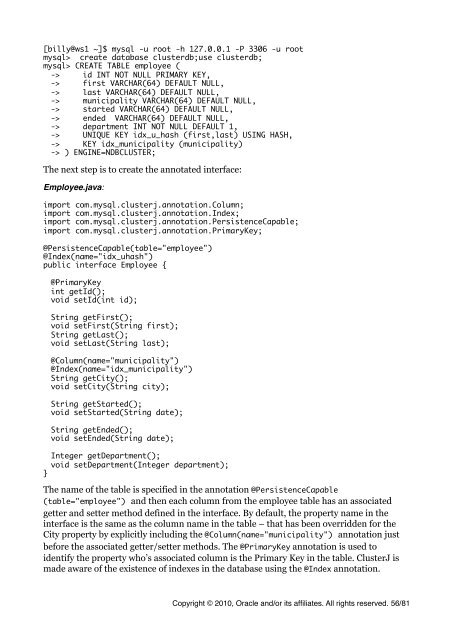MySQL Cluster Tutorial - cdn.oreillystatic.com
MySQL Cluster Tutorial - cdn.oreillystatic.com
MySQL Cluster Tutorial - cdn.oreillystatic.com
You also want an ePaper? Increase the reach of your titles
YUMPU automatically turns print PDFs into web optimized ePapers that Google loves.
[billy@ws1 ~]$ mysql -u root -h 127.0.0.1 -P 3306 -u root<br />
mysql> create database clusterdb;use clusterdb;<br />
mysql> CREATE TABLE employee (<br />
-> id INT NOT NULL PRIMARY KEY,<br />
-> first VARCHAR(64) DEFAULT NULL,<br />
-> last VARCHAR(64) DEFAULT NULL,<br />
-> municipality VARCHAR(64) DEFAULT NULL,<br />
-> started VARCHAR(64) DEFAULT NULL,<br />
-> ended VARCHAR(64) DEFAULT NULL,<br />
-> department INT NOT NULL DEFAULT 1,<br />
-> UNIQUE KEY idx_u_hash (first,last) USING HASH,<br />
-> KEY idx_municipality (municipality)<br />
-> ) ENGINE=NDBCLUSTER;<br />
The next step is to create the annotated interface:<br />
Employee.java:<br />
import <strong>com</strong>.mysql.clusterj.annotation.Column;<br />
import <strong>com</strong>.mysql.clusterj.annotation.Index;<br />
import <strong>com</strong>.mysql.clusterj.annotation.PersistenceCapable;<br />
import <strong>com</strong>.mysql.clusterj.annotation.PrimaryKey;<br />
@PersistenceCapable(table="employee")<br />
@Index(name="idx_uhash")<br />
public interface Employee {<br />
@PrimaryKey<br />
int getId();<br />
void setId(int id);<br />
String getFirst();<br />
void setFirst(String first);<br />
String getLast();<br />
void setLast(String last);<br />
@Column(name="municipality")<br />
@Index(name="idx_municipality")<br />
String getCity();<br />
void setCity(String city);<br />
String getStarted();<br />
void setStarted(String date);<br />
String getEnded();<br />
void setEnded(String date);<br />
Integer getDepartment();<br />
void setDepartment(Integer department);<br />
}<br />
The name of the table is specified in the annotation @PersistenceCapable<br />
(table="employee") and then each column from the employee table has an associated<br />
getter and setter method defined in the interface. By default, the property name in the<br />
interface is the same as the column name in the table – that has been overridden for the<br />
City property by explicitly including the @Column(name="municipality") annotation just<br />
before the associated getter/setter methods. The @PrimaryKey annotation is used to<br />
identify the property who’s associated column is the Primary Key in the table. <strong>Cluster</strong>J is<br />
made aware of the existence of indexes in the database using the @Index annotation.<br />
Copyright © 2010, Oracle and/or its affiliates. All rights reserved. 56/81
















